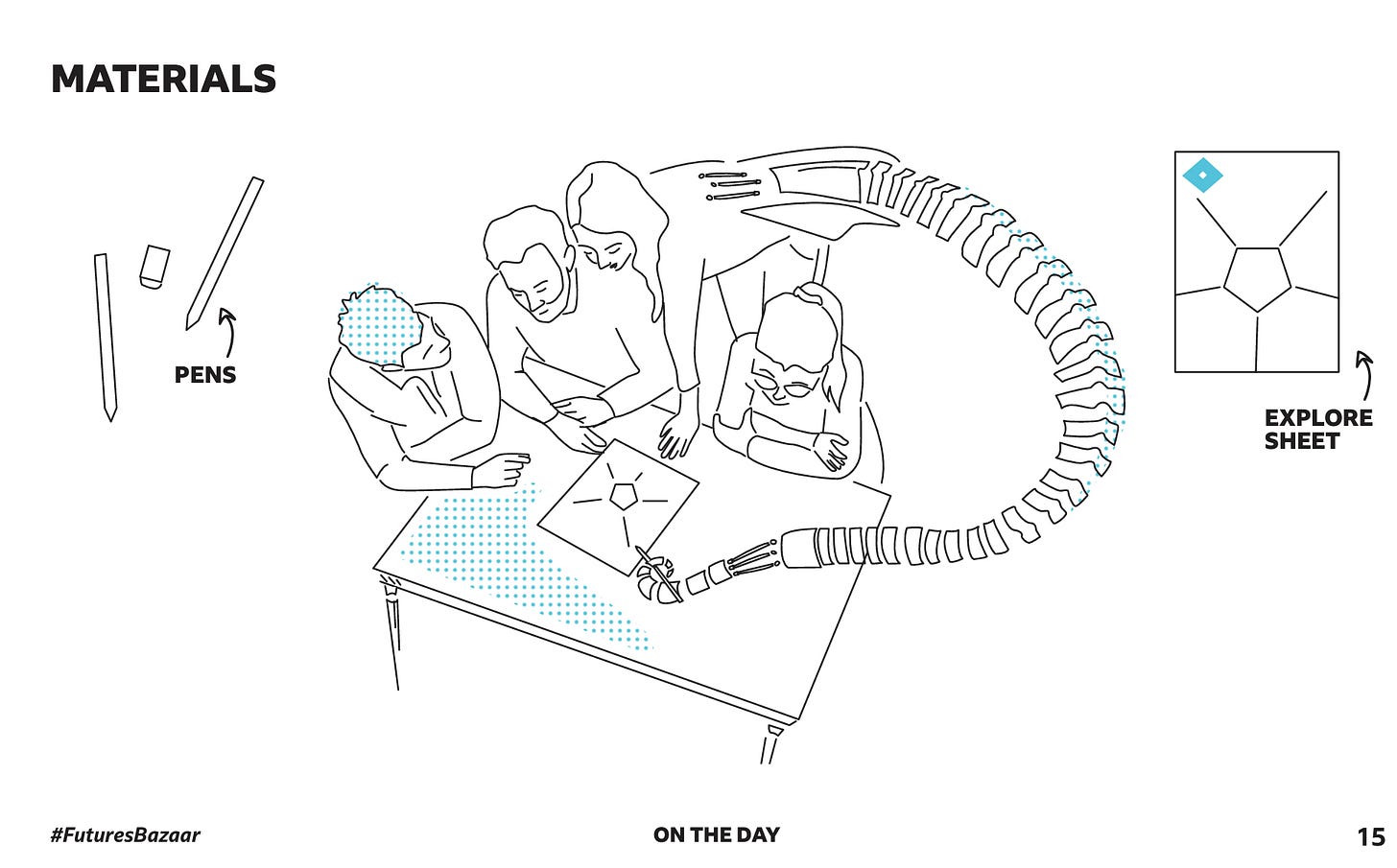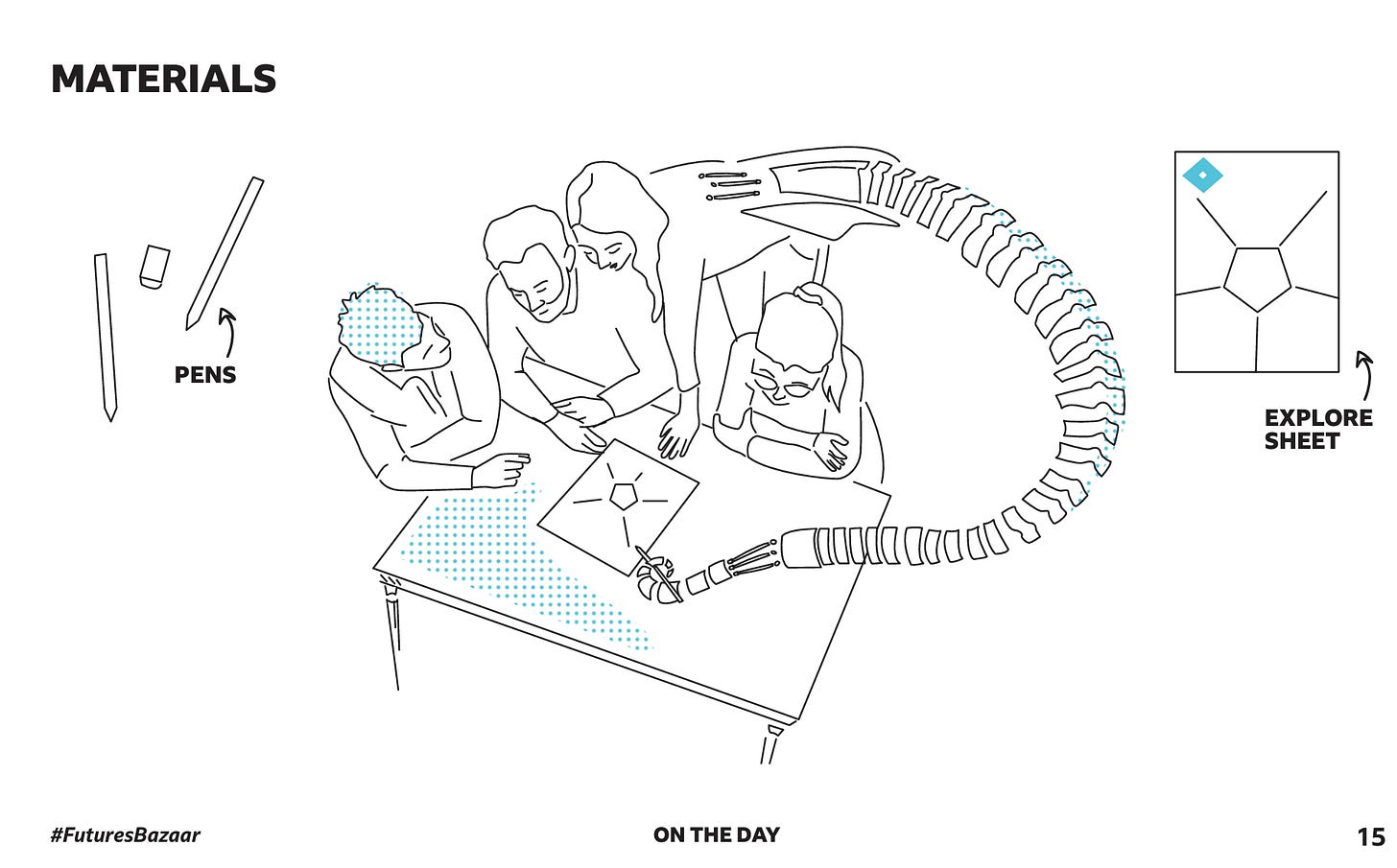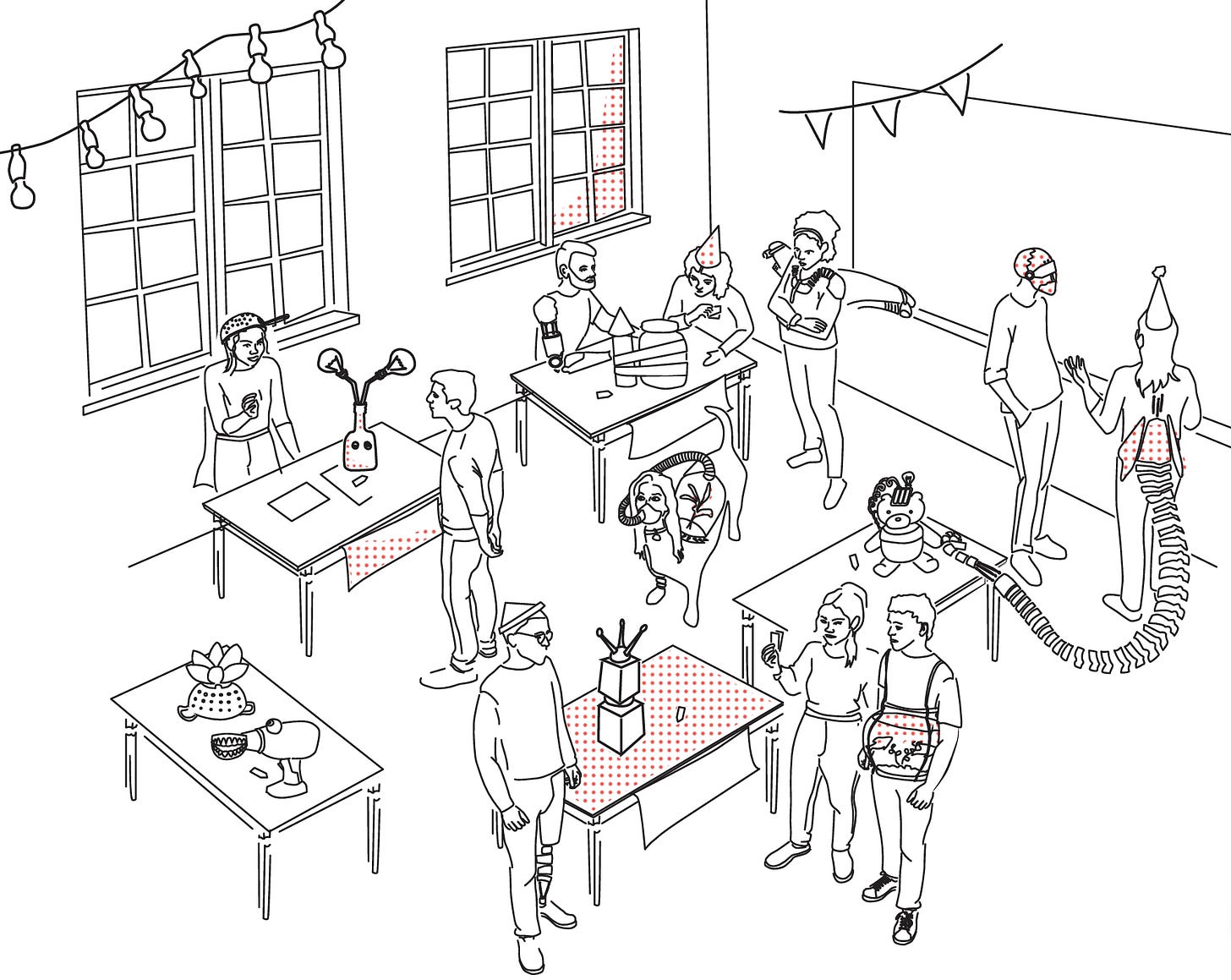14 October 2022. Futures | Music
The futures bazaar // From field recordings to folk rock—Vaughan Williams
Welcome to Just Two Things, which I try to publish three days a week. Some links may also appear on my blog from time to time. Links to the main articles are in cross-heads as well as the story. A reminder that if you don’t see Just Two Things in your inbox, it might have been routed to your spam filter. Comments are open. Have a good weekend.
1: The futures bazaar
The ‘futures bazaar’ is a participatory design futures method that was developed by the futurist Stuart Candy and Filippo Cuttica who was at the BBC when the project was run. The BBC has now published the instructions and assets that you’d need to run such a workshop yourself, with only some very light touch conditions, and made them available as a set of pdfs.
There is a disclaimer, though:
Disclaimer: for anything that happens if you use them.
Well, the future might be a dangerous place...
It’s described as a ‘public imagination toolkit’, and the good news is that because they have been published by the BBC, they look lovely. You can see the editorial care that has gone into the production, including the slightly quirky illustrations (by Marie Rasmussen).
(Image: The Futures Bazaar/ Marie Rasmussen).
So, the assets here include a manual for running the workshop, a slide deck to introduce it, and a set of print-outs that you use at different stages during the day to move the game along. The printouts include a warm up exercise, sheets for exploring and ideating, as well as artefact tags and bazaar currency.
In practice, this is an in-person workshop, although I’m sure that someone will adapt it to work online soon enough, and they say it ought to take around half a day. It seems to be able to scale up and down, depending on how many people you have.
Let me walk lightly through it to give a sense of the approach. One aspect that I like—which is probably where the word ‘Bazaar’ snuck into the name—is that participants are asked to bring to the workshop “Future Fodder” as feedstock for the design process:
Objects that they were otherwise planning to recycle or discard are ideal: examples might include a broken bicycle helmet, empty packaging, or a disused remote control from an old TV. Unique and unusual form factors can be particularly generative, which is something you could add when sending out the event invitation.
As the day starts there are a couple of warm up stages: the first looks quite like Stuart Candy’s ‘Thing from the Future’ game, which requires participants to juxtapose three items to make an unexpected future.
The second asks them to bring the world to life, by using a set of ‘STEEP’ questions—about society, technology, economics, environment and politics in this world. (More on this below).
(Image: The Futures Bazaar/ Marie Rasmussen).
And after that, with a world designed or developed, you get to the bazaar bit. First, they source the items they need from the shared ‘future fodder’ pile, and then they build something that has a relationship to the world they have designed:
This ideation step is structured like the Warm Up, with players generating future artefact ideas by combining a Future, a Thing and a Theme... Players have already been assigned a Future for their stall. Taking each of their team’s Future Fodder items in turn as the Thing at the centre of Themes from the Prompt Sheet and ask: how might this item be reimagined and remade as a distinctive artefact from their particular future?
Then you make your items, and build your bazaar stall, ahead of the grand opening—merchants, customers, and currency:
A bazaar is nothing without its merchants and customers. You’ll remind participants that they should prepare to be in character, and when the bazaar launches, they’ll have a chance to play on both sides of the stall. As merchants, what lines might they say to attract customers? suitable costumes?
(Image: The Futures Bazaar/ Marie Rasmussen).
One tweak that I liked here was that you might want to open the bazaar to people who hadn’t been involved in the game so far, as long as you briefed them and gave them some money to spend.
And, of course, recording all of this can be invaluable.
Reading the manual and reviewing the assets, but without having done one of these live, I can see that they would put a lot of energy into the room. There’s a good mix of talking and making, heart and hands. Some of the conversations would be a lot of fun; I can imagine that there would be quite a lot of laughter, which is one of my indices of a successful workshop.
I think I’d want to add on 30 or 40 minutes to the process to bring people gently back out of role and have a bit of a learning conversation.
I’m not a huge fan of STEEP—it’s simple but a bit clunky, so I might substitute Richard Lum and Michele Bowman’s VERGE for this, since its five (or six) questions are a better incasting tool for world building.
If I have a reservation, it is about the use of objects (so this is more a questions about design futures in general). Yes, developing objects is a way to make a possible future both different and tangible, and that is one of the reasons we all do futures work.
But I worry that the objects/bazaar metaphor reduces the future to things (Stuart may correct me on this) whereas a lot of the futures innovation we need right now is around systems and processes. Products is what has got us into the mess we’re in today. We need more socialinnovation. But that’s also one of the reasons I’d want to have a learning reflection session at the end—to put the products that have been bought and sold at the bazaar back into their larger context.
The assets for The Future Bazaar can be downloaded here.
2: From field recordings to folk rock
I didn’t have much spare time yesterday, so I am sharing a piece that I wrote on Vaughan Williams and folk music for the Salut Live! blog. This was published on Wednesday to mark Vaughan Williams’s 150th birthday, and it looked at the legacy of the songs that RVW (as he seems to be called by his aficionados) referenced in his English Folk Song Suite.
If you don’t know this piece, here’s a recording:
There are ten folk songs heard in the Suite, and some have stupendous modern versions. Some were increasingly rare when the song collectors—Cecil Sharp, Percy Grainger, RVW, among others—fanned out across the British countryside in the 1890s and 1900s with their wax cylinder recording machines looking for singers of the country’s traditional songs. Regular readers will know that I have written about some of this here before.
Vaughan Williams was a serious folk song collector—he made hundreds of trips in the 1910s, and later became President of the English Folk Dance and Song Society.
But by some accounts, he was more interested in the music than the words—sometimes he’d only make a note of the first verse, sometimes not even that, if he knew of a broadsheet with the words on it. At least the wax cylinder recordings would allow someone to transcribe the words later:
The original (of Pettry Caroline, one of the Folk Song Suite songs) was recorded by Vaughan Williams, and it gives us a chance to hear the material he was working with.
From the notes in the British Library Archive:
“Poor quality recording with heavy surface noise. Mrs Powell has a false start... The false start may be explained by Ella Leather's comment to Ralph Vaughan Williams that Mrs Powell was a bit shaky and banged against the table that the phonograph was on.”
The recording can be heard here.
The Salut Live! Works through all of the 10 songs, finding good modern recording by well known folk singers for most of them, including a performance by a young Joni Mitchell on the Canadian folk show ’Let’s Sing Out’ which is preceded by an interminable anecdote about a kangaroo. Me neither.
This being Just Two Things, i’m going to pull out two of these here:
Dives and Lazarus was traditionally sung at Christmas, but the song had almost died out when Cecil Sharp collected it in the 1910s. Obviously the version that June Tabor sang with the Oysterband on Freedom and Rain is outstanding.
'John Barleycorn’ is an ancient song, which Robert Burns wrote a version of in the 18th century. It has been covered by almost everyone. For me it’s hard to look beyond the version Steve Winwood did with Traffic in 1970–Traffic had heard the version sung by the Watersons—but youtube threw up a solo acoustic version done by a much older Winwood.
I recall reading a theory that John Barleycorn was a protest song as well as a song about drinking—the gentlemen kept cutting down John Barleycorn, but he keeps growing back up again. Well, you can see the metaphor. But light Googling failed to find any suggestion of this.
All the same, this does link to why Vaughan Williams was interested in folk music. At one level, as I discussed last time, he thought—with Holst—that folk music could help rejuvenate an authentically English classical music. But there’s more to it than just this, as Rowan Williams discussed in a recent review of a Vaughan Williams biography:
He was as devoted as any Gareth Malone to communal music-making, from his early days as a (somewhat rebellious) church organist to his work with the Leith Hill Musical Festival, conducting amateur orchestras and choirs.
And Vaughan Williams didn’t think that music was about high art:
it was something that came from the grass roots and was always nourished by them, something that needed to return to local and popular tradition to be revived.
Vaughan Williams was very comfortably off—family money meant that he didn’t have to work. But that family money came from the inter-married Wedgwood and Darwin families (those Wedgwoods, that Darwin), which meant (without overdoing this point) that to some extent he sat outside of the tight social conventions that tended to go with English money in the late 19th and 20th centuries. He’s known to have turned down a knighthood.
And as I said in the Salut Live! Piece:
He died in 1958, but my guess is that he would have been thrilled by the resurgence of British folk music in the ‘60s, ‘70s, and ever since.
The whole article is at Salut Live! My thanks to Colin Randall for publishing it.
j2t#382
If you are enjoying Just Two Things, please do send it on to a friend or colleague.





